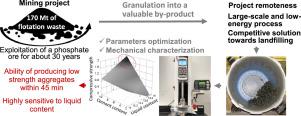Resources, Conservation and Recycling ( IF 13.2 ) Pub Date : 2021-04-27 , DOI: 10.1016/j.resconrec.2021.105605 Elisabeth Viry , Lan-Huong Tran , Louis-César Pasquier , Jean-François Blais , Guy Mercier

|
Mining residues are usually stockpiled because of their understudied physico-chemical properties and of their abundance, which make their valorization challenging. In this work, a cold-bonding granulation apparatus was built in order to transform a mining residue sludge from an apatite ore, into artificial aggregates suitable for use in civil engineering. A 25 rpm rotation speed, 15° angle relative to horizontal, and an ideal feeding amount of the granulation drum, as such as the liquid (supernatant) distribution method, were preliminary determined. Effects of rotation speed, liquid content, and granulation time were then studied to evaluate the best combination for appropriate aggregate size distribution. Box-Behnken experimental designs were used to investigate the evolution of compressive strength of the individual aggregates when Portland cement is added to the mix, and when granulation time varies, around the critical liquid content of 14% of total weight. Thus, the possible parameters combinations which allow a maximization of compressive strength without exclusively increasing cement content, were determined and used to confirm the Box-Behnken predictions. Spherical aggregates were thus manufactured, with diameters mainly comprised between 5 and 40 mm, and compressive strength comparable to those of commercialized aggregates, up to 7 MPa and to 3 MPa for aggregates with diameters respectively below and above 10 mm. Paths for greater consolidation as prior homogenization, use of humid cure conditions, and use of other additives emerge from literature and from the results presented.
中文翻译:

通过制造人造骨料来评价磷灰石采矿浮选残渣的价值
通常会存储采矿残留物,因为它们的物理化学特性及其丰富的特性被低估,这使其增值具有挑战性。在这项工作中,为了将磷灰石矿石中的残渣污泥转化为适用于土木工程的人造骨料,建造了一个冷粘结制粒设备。预先确定诸如液体(上清液)分配方法的25rpm的转速,相对于水平的15°角以及成粒鼓的理想进料量。然后研究转速,液体含量和制粒时间的影响,以评估适当的骨料粒度分布的最佳组合。使用Box-Behnken实验设计来研究当将波特兰水泥添加到混合物中时以及当制粒时间变化时,单个集料的抗压强度的演变,其临界液体含量约为总重量的14%。因此,确定了可能的参数组合,这些参数组合可在不专门增加水泥含量的情况下最大化抗压强度,并用于确认Box-Behnken预测。由此制造出球形骨料,其直径主要在5至40mm之间,并且抗压强度与商业化骨料的抗压强度相当,对于直径分别小于和大于10mm的骨料,分别达到7MPa和至3MPa。通过预先均质化,使用潮湿固化条件来实现更大固结的途径,



























 京公网安备 11010802027423号
京公网安备 11010802027423号